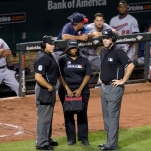What it's really like to slam your brain against your skull during a football game
Shortly after I suffered my first concussion, I fell off of a bench, vomited, cried, and repeatedly asked what had happened—but insisted that I was okay and nothing was seriously wrong. There was a football game to be played, after all.
It happened in the first half of a game during my freshman season of football at Kenyon College. I was running down the field during kickoff coverage—a play that many deem the most dangerous in a sport full of car-crash collisions—when a three-player wedge block crashed into me like a tidal wave and sent me sprawling head-over-heels to the turf, my brain smacking against my skull in the process.
I stayed in the game a while longer, at first showing no signs of cognitive damage. I had my deeply ingrained football instincts to fall back on and responsibilities to my team to fulfill. No one questioned me so long as I could do my part.
Then the confusion set in. I remember being unsure which direction a play needed to be run, a momentary panic that, as a first-year player still learning the ins and outs of college football, was a dreaded feeling only a few games into the season. But this uncertainty wasn’t because of my inexperience. As the game wore on, I became increasingly mentally and physically affected until, as long snapper, I launched the ball twenty yards over the punter’s head—a comically large margin. At that point, my coaches and athletic trainer pulled me from the action. My condition quickly deteriorated to the vertiginous and emotionally volatile state of the badly concussed.
In the movie Concussion, set to be released on Christmas Day, Will Smith will immortalize forensic pathologist Dr. Bennet Omalu’s discovery of chronic traumatic encephalopathy, a degenerative disease linked to repeated head trauma. The conversation around the film—along with the circumstances of the last few years, in which too many players have lost their lives to the disease and the sport’s leaders have finally begun to take head trauma seriously—has led me to relive the horror of my own concussions. When I suffered these injuries, I lost control of my physical self, my personality morphed, and my brain felt like a million scattered puzzle pieces. The fact that the sport once took concussions lightly is deeply troubling to me.
Even today, the popular perception of what a concussion looks like is misguided. Unlike football’s more obvious and immediate damage to bones and tendons, the effects of a brain injury aren’t always visible immediately after impact—they lurk insidiously beneath the surface. According to Heads Up, the Centers for Disease Control and Prevention’s youth sports brain health initiative, concussions rarely result in a loss of consciousness—the classic scene of a gruff old coach reviving a knocked out player with smelling salts is mostly a dramatic flight of fancy.
-

-

-

-

-

-

-

-

-

-

-

-

-

-

-

-

-

-

-

-

-

-

-

-

-

-

-

-

-

-

-

-

-

-

-

-

-

-

-

-

-

-

-

-

-

-

-

-

-

-

-

-

-

-

-

-

-

-

-

-

-

-

-

-

-

-

-

-

-

-

-

-

-

-

-

-

-

-

-

-

-

-

-

-

-

-

-

-

-

-

-

-

-

-

-

-

-

-

-

-

-

-

-

-

-

-

-

-












































































































